Weapons
Dao (Sword)
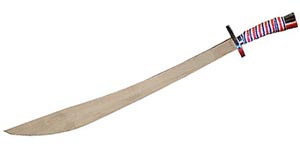
Dao is a category of single-edge Chinese swords primarily used for slashing and chopping (sabres), often called a broadsword in English translation because some varieties have wide blades. In China, the dao is known as one of the four major weapons, along with the gun (staff), qiang (spear), and the jian (sword), and referred to as "The General of All Weapons". Dao is actually a generic word used to denote any member of a family of single-edged, broad-bladed cutting or slicing tools, but in common, everyday usage means knife.
Qiang (Spear)

Qiang: the spear in many variations was ubiquitous on the pre-modern Chinese battlefield. It is known as one of the four major weapons, along with the Gun (staff), Dao (sabre), and the Jian (sword), called in this group "The King of Weapons". Common features of the Chinese spear are the leaf shaped blade and red horse-hair tassel lashed just below. The tassel serves a tactical purpose, and is not simply for decoration.
Jian (Straight Sword)
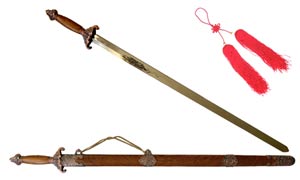
In Chinese folklore, it is known as "The Gentleman of Weapons" and is considered one of the four major weapons, along with the Gun (staff), Qiang (spear), and the Dao (sabre). Straight sword technique is ancient and prestigious, handed down from ancient times with characteristics: elegant, robust and strong.
Gun (Staff)

Gun (Staff): Gun is a long Chinese staff weapon used in Chinese martial arts. It is known as one of the four major weapons, along with the qiang (spear), dao (sabre), and the jian (sword), called in this group "The Grandfather of all Weapons".
Fu Zi (Axe)

Fu Zi (Shaolin Axe): In its most common form, an arm-length weapon borne in one or both hands. Compared to a sword swing, it delivers more cleaving power against a smaller target area, making it more effective against armor, due to concentrating more of its weight in the axehead. However, it allows much less precision than a sword does.
Yue Ya Chan (Crescent Moon Spade)
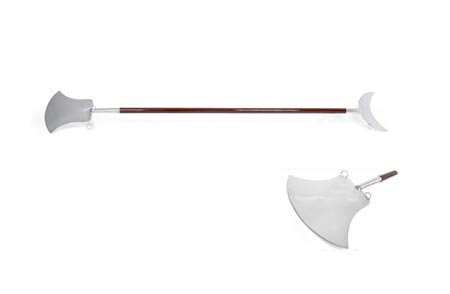
Traditional crescent moon spade, aka monk spade, with wooden shaft, and a chromed rigid steel head. It is a Chinese pole weapon consisting of a long pole with a flat spade-like blade on one end and a smaller crescent shaped blade on the other. In old China, Buddhist monks often carried spades (shovels) with them when travelling. This served two purposes: if they came upon a corpse on the road, they could properly bury it with Buddhist rites, and the large implement could serve as a weapon for defence against bandits. Over time, they were stylised into the monk's spade weapon.
Shuang Gou (Twin Hooks)
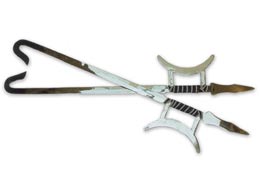
The Hook Sword or Shuang Gou also known as Hu Tou Gou (tiger-head-hook) is an exotic Chinese weapon traditionally associated with Northern styles of Chinese martial arts, but now often practiced by Southern styles as well.
Shuang Dao (Double Broad Sword)
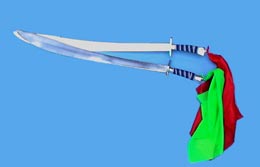
Shuang Dao is the wielding of two broadswords simultaneously.
Jiu Jie Bian (Nine Sectional Chain)
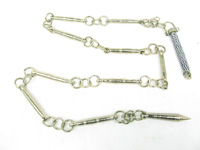
The chain whip is a weapon used in some Asian martial arts, including Chinese martial arts, in addition to modern and traditional wushu. It consists of several metal rods, which are joined end-to-end by rings to form a flexible chain. Generally, the whip has a handle at one end and a metal dart, used for slashing or piercing an opponent, at the other. A cloth flag is often attached at or near the dart end of the whip, and a second flag may cover the whip's handle. The flag or flags enhance a wushu performance by adding visual appeal, and by producing a rushing sound as the whip swings through the air. They also help stabilize the whip, enhancing the performer's control.
San Jie Gun (Three Sectional Staff)

A Chinese flail weapon that consists of three wooden or metal staffs connected by metal rings or rope. A more complicated version of the two section staff, the staves can be spun to gather momentum resulting in a powerful strike, or their articulation can be used to strike over or around a shield or other defensive block.
Mu Yang Bian (Shaolin Whip)
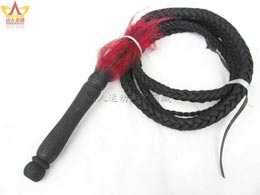
The whip of the Shaolin monks is 2.5 m long and consists of four parts, the handle: of the length of a forearm, is rigid and has a slot to secure the wrist. Above the hole is a red clump, which hides the hand. At the bottom of the weapon dangle two flakes similar to those of the straight sword, one red and one yellow, to distract the opponent's view from the weapon action.
Shuang Chui (Melon Hammers)
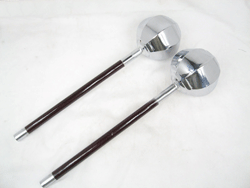
This weapon was traditionally used with brute force, as the strength needed to heft such weapons was considerable. As a result, this weapon is not often practiced by kung fu enthusiasts, and newly made replicas may be hollow. However, routines for this weapon still exist in some styles. Chui are almost always used in pairs.
Shuang Qiang (Double Spears)
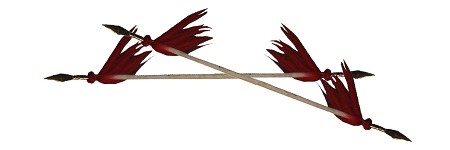
The double spears have peculiar features. Each spear has two heads, so the practitioners can attack in four directions. The two spears coordinate well, often with one attacking and the other defending. The spears are swung quickly enough to dazzle the enemy and attack at the first sigh of weakness. Often used techniques are cloud, thrust, swing with figure-8, and press. Movements are sweep in a figure-8 form, chop, point, block and thrust.
Pu Dao (Long Staff Broad Sword)
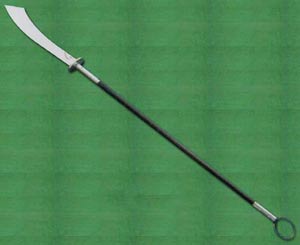
The halberds are part of the long weapons family. The pudao is also known as the horse-cutter sword as it was used to slice the legs of the horses during battle to dismount the horsemens. Pu Dao was originally an edged infantry weapon which is still used for training in many Chinese martial arts. The blade of a podao is shaped like a Chinese broadsword, but the weapon has a longer handle usually around one and a half to two meters (about four to six feet) which is circular in cross section. It looks somewhat similar to the guandao.
Chun Qiu Da Dao (Broad Swords)
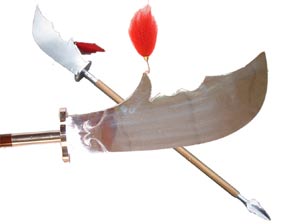
The halberds are part of the long weapons family. It is an ornate version of the Pu Dao long sword. Traditionaly used to dismount the horsemens, the tail of the weapon could also be used as a spike or to hook the opponent. Due to the weight if the blade, the use of this weapon requires strenght, agility and coordination.
Emeici (Emei Daggers)
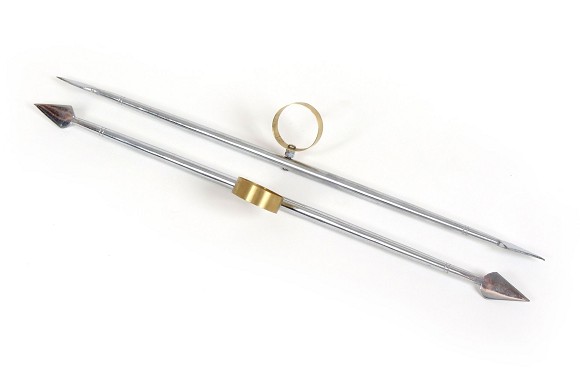
Emei Daggers are a traditional Chinese martial arts weapon. They are a pair of metal rods with sharp ends used for stabbing; they are typically mounted on a detachable ring worn on the middle finger, allowing them to spin and be elaborately manipulated. These weapons originated at Mount Emei (hence the name). They are a piece of equipment used in wu shu to this day. These weapons are used for 'open palm' techniques, and are similar to 'judges pens'. The general idea of this weapon is to confuse attacker by spinning the blades thereby distracting in order to get close enough to stab. Also, emeici can be concealed easily for surprise attacks.
Damo Zhang (Bodhidharma's Stick)

The Shaolin Bodhidharma's Stick is one of the rare weapons in Shaolin Wushu. It has a unique shape, just like a walking stick in an old man's hand. The movements in this routine are fierce, vigorous, simple, natural and poised. It cleverly and reasonably utilizes the techniques of attack and defense, so it can both attack and defense. This routine lays especially stress on the eyes techniques. When the hands move, the eyes follow them. If preserving in practicing this routine, you may able to improve the strength of hands..
Shuang Fu (Double Axe)
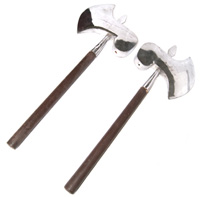
Double axes are short traditional weapon very powerful, used with two hands.
